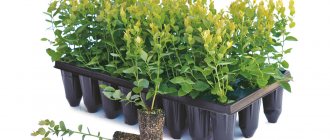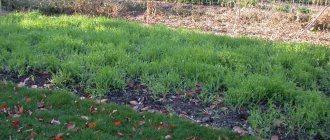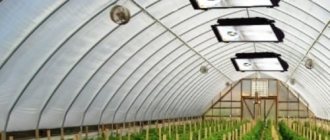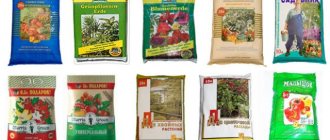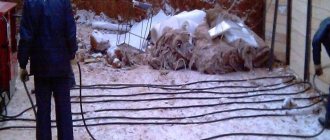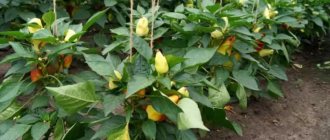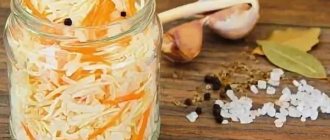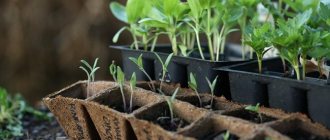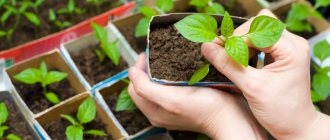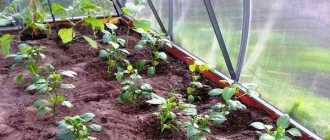Every year, in early spring, thousands of gardeners begin preparing for the new season. They plant various crops as seedlings, carefully look after them in order to get a good harvest, healthy and high-quality shoots, ready for planting in open ground.
At the same time, various questions and difficulties arise, for example, how to choose containers for seedlings and which ones are better. This is exactly what this article will discuss.
What is a cassette
Seedling cassettes are special containers for sowing seeds. These are individual containers fastened together, where each individual shoot grows separately from the others.
This method of sowing is considered the most convenient and practical. You can buy cassettes at any grocery or gardening store at a low price.
Cassettes for seedlings are presented in the form of blocks of various sizes, divided into individual containers with a volume of 20 to 500 ml. Most often you can find 4, 6 or 8 cassette blocks on the shelves.
The walls of the cassettes are dense, they do not allow the root systems of neighboring plants to touch, which allows you to get healthy and even shoots.
Not only the size of the cassette cells plays a big role, but also the material from which they are made
The most common on the shelves of gardening stores are the following:
- made of plastic;
- from pre-compacted cardboard and waste paper;
- made from peat - a natural material that decomposes in the soil.
The container is selected for each individual crop. It all depends on how deep and wide the plant grows.
Coconut or peat washers, which is better?
Both agronomists and gardeners are pondering this question. There is no consensus yet.
- Peat tablets are ideal for the development of crops at an early stage, that is, after planting the seeds, during the pecking period, and active growth. The lightweight peat humus substrate breathes well and allows water to pass through well. Peat consists of rotted plants growing in swamps. Contains enough nutritional components to provide seedlings with everything they need.
- Coconut cylinders are made up of fibrous coke husks. However, it has been proven that coco soil has increased breathability. Thanks to the unique composition and characteristics of coke pucks, the germination of seeds of shrubs and trees, vegetables and flowers increases. Strong and completely hopeless and weak.
- Due to the air permeability of the coco-soil, the roots breathe well, as a result of which nutrients reach the seedling faster. Also, a large amount of air in coconut soil significantly reduces the risk of putrefactive fungi and diseases.
- Peat tablets have lower breathability. As a result, when overwatered, seedlings can turn sour, get sick and die. On the other hand, a lot depends on the gardener. If you follow the watering regime and do not overwater the bed, there will be no danger of infection with rot and fungi.
Food for thought! Agronomists are unanimous in their opinion that for active growth and full development, seedlings need at least 20% air in the soil. This parameter is typical specifically for coke soil.
Is it worth buying seedling cassettes?
Is it worth buying seedling cassettes? Here each gardener makes his own decision. In fact, they are very practical and easy to use.
Here, each seed is placed in an individual container, so subsequently young plants do not need to be picked or planted in separate jars
There are other significant advantages of using it. Let's take a closer look at them.
Pros when using
To date, seedling cassettes are widely popular among gardeners. This is explained by a large list of advantages, which include:
- Each seed is placed in an individual compartment of the cassette and grows in it until transplanted into open ground; no replanting is required. This is especially good for plants with a weak root system, the replanting of which in most cases ends in the death of young shoots.
- Additional lighting. As a rule, seedlings begin to be planted in late winter - early spring. During this period, most regions of Russia experience increased cloudiness, all days are mostly cloudy, and the sun rarely comes out for long. This is detrimental to the seeds because they require sufficient amounts of solar energy to germinate. So, it is convenient to place seedling cassettes under ultraviolet lamps.
- An abundance of shapes and sizes of cassettes. For each individual crop, you can choose your own container, from which it will later be more convenient to transplant young shoots into open ground.
- Each cassette has drainage holes to help remove excess moisture. This will protect the plant, in particular its root system, from rotting.
- Convenience of placement. Typically, gardeners use disposable plastic cups for seedlings. They are very inconvenient, unstable, and require a fairly large space on the windowsill. The same cannot be said about compact cassettes.
- It is convenient to move seedlings in cassettes and take them outside for hardening.
- The cassettes can be separated by simply cutting off the required ones with scissors. For example, you can remove unhealthy shoots or seeds that have not sprouted.
Cassettes for seedlings help save soil mixture.
They are, as a rule, shallow, but this size is sufficient for normal growth and development of shoots. All of the listed advantages indicate that every gardener should purchase cassettes, since they greatly simplify the process of growing seedlings.
But at the same time, there are also disadvantages that you also need to be aware of.
Flaws
Along with the advantages, it is necessary to consider the disadvantages of seedling trays. These include:
- The need for constant watering. As already mentioned, the cassettes are produced at a shallow depth, so the volume of soil dries out quickly.
- It is unprofitable for large volumes, since you will need to purchase a fairly large number of seedling cassettes. If the containers are plastic, they can be left for next year if used carefully. And peat or paper ones will have to be purchased every season.
- Containers require additional disinfection.
- An incorrectly selected cell size will result in young seedlings not having enough space to grow and develop, so they may wither.
Products that are too cheap are usually made from low-quality plastic, which can be toxic
For planting, it is necessary to use only high-quality cassettes and select them according to the size of the crops being planted.
The vegetable garden is the breadwinner
First, a little about why I came to this method. The main reason for switching to cassette cultivation was the uneven emergence of seedlings. How did I grow seedlings before? You sow 10-20 seeds of pepper or another crop into a container and place it in the warmest and, as a rule, darkest place. And when the first shoots (loops) appear, it is necessary to immediately take them out to a much cooler windowsill, and even with lighting. But in this case, if you bring the entire container into the light, in which only 3-4 loops have appeared so far, the remaining seeds, having found themselves in new conditions, are significantly delayed in germination and can appear only after 10-20 days. By this time, it’s time to replant the first shoots. In this case, those plants that have not yet sprouted, but have already hatched, are injured.
If you wait for the bulk of the seedlings in that warm place, then the first plants stretch and even fall, dying. But when each seed sits in its own separate “nest,” then such a problem does not exist: just look more often (2-3 times a day) and take out the emerging shoots to a bright place. This is the first and main advantage of the cassette method!
The second advantage is that we usually start growing the first pepper seedlings at the end of February, and the daylight hours are still very short. Therefore, with the help of backlighting, we increase it to 14-16 hours. And these small cassettes with still small shoots can easily be placed under one fluorescent lamp, which saves energy consumption.
Features of cassette growing
The cassette growing method has its own distinctive features. And, if the choice is on this method, you need to study them in order to get good young shoots ready for transplanting to open ground:
- fill the cassettes with light porous soil. Usually the soil is sifted through a sieve before planting;
- plants in cassettes must be watered with a growth stimulator or special vitamin complexes;
- in order to increase seed germination, it is recommended to cover the cassettes with a plastic bag or film to create a greenhouse effect;
- It is recommended to place the cassettes in a warm, sunny place where the temperature is about 20-22°C - this is normal room temperature.
After about 40-60 days, the seedlings are ready for transplanting into open ground. The exact date can be seen on the seed packaging
The experience of gardeners shows that when growing seedlings in cassettes, about 95-97% of the seed germinates. And with the usual method, this figure is only 75-80%. This is another reason why the cassette method is popular.
Preparing seeds for sowing
The preparation of seed material (germination of seeds) begins the moment the soil is covered with film. Selected seeds with high germination are scattered between two boiled and well-wrung out pieces of cotton cloth . The rag with seeds is rolled up and wrapped in plastic film or a bag. The bundle is placed in a warm place.
The seeds are monitored daily: as soon as white sprouts appear, it’s time to sow.
What can you grow?
The cassette method of growing seedlings is very popular among gardeners. And, above all, due to the fact that it is suitable for almost all types of crops:
- any flowering plants;
- tomatoes;
- cucumbers;
- squash;
- cabbage;
- zucchini;
- bell or green pepper;
- strawberries and garden strawberries;
- radish.
Moreover, you can plant not only seeds, but also cuttings and bulbs
It turns out that the cassette method is suitable for all methods of plant propagation.
Adviсe
Before purchasing a container for seedlings and for it, you need to learn some subtleties about the plants themselves.
- After the consumer asked the question - what type of container is better to buy? – it is worth studying what type of root system the crop that will be planted in the future has. And in accordance with the latter, decide what you need to buy - a box or a cassette.
- How exactly to grow this plant - does it need a container with or without a drainage hole?
Following these recommendations and the selection criteria indicated above, it will be very easy to make a purchase that you will not regret later.
Quality check
When buying cassettes for seedlings, you need to be extremely attentive to the product. The quality of the harvest largely depends on this. To select the right container, it is recommended to follow these recommendations:
- It is advisable that the disembarkation cassettes be packed in sealed vacuum packaging. It must be intact, without damage or defects. It is better not to take a product with damaged packaging, since in this case the storage rules were violated;
- The cassettes should be made of dense material and hold their shape well. In addition, they should be predominantly made from natural ingredients. Toxic components can negatively affect young seedlings;
- It is better to take medium-sized cassettes, not too deep. They are ideal for various crops.
Instructions from the manufacturer should be included with the seedling cassettes. It is also recommended to study it carefully, since each product has its own individual characteristics.
Size matters
Cassettes for seedlings differ primarily in the material from which they are made. But there is another classification - according to overall dimensions and number of cells.
For different crops, individual containers are selected based on depth and wall thickness.
For most plants, medium-sized containers are suitable, but there are exceptions:
- It is recommended to plant early cabbage, strawberries, tomatoes and cucumbers in cells with a volume of up to 70 ml;
- sweet peppers - into cone-shaped deep containers with a volume of up to 40 ml.
For greens, dill and parsley, leeks, onions, herbs, late cabbage, cells of the smallest volume are used.
Some manufacturers offer a line of cassettes for each type of crop. They develop special tables from which the gardener can understand which type of cells is most suitable.
In general, the principle is as follows: if the plant has a developed root system that goes deep, then select narrow and deep containers. If the root system develops predominantly in breadth - shallow but wide cells.
Selection of cassettes, application
Each crop has its own characteristics and features that must be taken into account when growing seedlings: soil composition, need for lighting, humidity, root volume, plant height. Taking these requirements into account, you can choose cells of any size and height, small or large block, with or without a tray.
Cassettes are also convenient to use because you can cut out a block of the desired size and place it separately so that plants with different needs do not interfere with each other. For example, short seedlings, being in a cassette next to tall ones, will receive less light, and air will circulate poorly between them. Instead of a pallet in this case, you can use polyethylene with dimensions slightly larger than the size of the block.
Tomatoes, peppers, and eggplants are planted in small-volume cells (50-70 ml), but tall and cone-shaped ones are chosen for peppers and eggplants, because their roots grow deep; tall seedlings and saplings are grown in larger volumes (200-450 ml). large plants, for example, watermelon, melon, pumpkin. Cabbage seedlings are grown in medium-sized containers (100-150 ml), but always with a tray, because the moisture requirements are increased. For a voluminous root system, large cells with a removable bottom are selected, and the smallest ones are suitable for planting basil, dill, and parsnips.
A super way to grow tomato seedlingsHomemade containers for growing tomato seedlings are very popular among vegetable growers. This allows you to give a second life...
Which seedling cassettes are better?
Nowadays, there are three main types of seedling trays that are most common:
- plastic, made of PVC or polystyrene. They are usually reusable and can be used for several seasons in a row;
- peat or biodegradable. They are used for one season. Plants from them are not transplanted into open ground, but are planted together with cells, since peat quickly decomposes in the soil, turning into a natural fertilizer;
- paper ones are another eco-friendly option, but they can only be used for one season. They are made of thick cardboard or waste paper, non-toxic and safe for plants.
Let's take a closer look at each type.
Plastic
As already mentioned, plastic cassettes are made of dense material PVC or polystyrene .
You can find out what type of plastic they are made from by the corresponding markings on the bottom of the container. It is recommended to choose cassettes made of biodegradable plastic, since it is less toxic and less dangerous for the environment, and does not have a pungent, toxic odor.
Plastic cassettes have the following advantages:
- a variety of sizes and shapes, which allows you to select an individual container for each garden crop;
- easy to use: they can be cut, moved, arranged as convenient;
- there are drainage holes at the bottom and a tray to collect excess moisture;
- no picking of young shoots is required, since each seed is initially planted in an individual container;
- the death of the plant in case of transplantation due to damage to the root system is excluded;
- durability: they last about 3-5 years, they can be washed and stored.
The cassettes usually come with a tray on which they can be placed. With its help, you can transfer seedlings, take them under ultraviolet lamps or outside for hardening. There may also be a special cover that replaces the film to create a greenhouse effect.
Paper
Paper cassettes are also used for growing seedlings. They are produced in a single block of 4, 6, 8 or 10 cells. They are very convenient to use, especially when transplanting: the container is easily cut with scissors, and the young shoot is removed along with a lump of surrounding earth.
Some manufacturers produce paper-peat containers that can decompose in the soil of a vegetable garden or garden under the influence of air, moisture, sunlight and the action of microorganisms.
But you should know that when paper decomposes, it displaces nitrogenous substances from the soil, so additional feeding is required with fertilizers containing this microelement. Urea is ideal.
The disadvantages of these cassettes include the following points:
- The need to buy cassettes every year;
- With an abundance of moisture, the walls of the cells soften, they can become moldy and infect young shoots with fungus, which will make transplanting to open ground impossible.
Paper seedling cassettes are rarely used for seedlings; peat containers are usually preferred.
Peat
Peat cassettes are made from peat - a natural material that decomposes in soil under the influence of moisture, bacteria, sunlight and oxygen. It turns out that the roots of young shoots receive additional fertilizer during the period of active growth on the soil.
Peat cassettes for seedlings have the following advantages:
- natural material that does not contain harmful additives and is absolutely safe for the environment;
- the walls of the cassettes allow air to pass through well, which will prevent rotting and diseases of the root system;
- no picking of young shoots is required, which completely eliminates the death of the plant during transplantation due to damage to the root system;
- low cost compared to previous options.
Peat trays for seedlings
When growing seedlings in peat trays, it is necessary to carefully monitor watering. An abundance of moisture can lead to soaking of the walls, and a lack of moisture can lead to drying out of the earthen clod.
As in the case of paper cassettes, peat cassettes take nitrogen from the soil when decomposing, so fertilizing is required.
How to choose tablets
What to look for when choosing:
- Quality and structure of peat substrate. It should be free of foreign inclusions and various coarse fibrous structures. Their presence indicates that the product is of poor quality. In addition, coarse fiber tablets will not breathe well. There is a high probability of stagnation of water, damage to seedlings by gray rot, black leg and other diseases.
- Diameter. To grow seedlings of large, fast-growing crops, it is worth choosing washers of a larger diameter. For small ones - on the contrary, small. This is important because the wrong choice leads to problems and difficulties. For example, if a small tablet is selected, and the sprout is large, a situation may arise when the plant is not yet ready for transshipment, but has already outgrown its planting area. For small seeds, washers with a diameter of 2-3 cm are suitable, for large ones - 7-9 cm. The most popular are cylinders of 4-5 cm. Suitable for most gardening and indoor crops.
- Soil acidity or pH. The parameter must be indicated on the manufacturer's packaging. It is selected taking into account the requirements for growing a particular crop. For example, for coniferous trees the optimal pH is 4.5. For rhododendrons, hydrangeas, azaleas and a number of others - 5.5-6.3. Most gardening and household crops are satisfied with an acidity of about 5.3-5.7. At this pH, seeds of green and spicy crops, vegetables, flowers and others quickly germinate.
- Availability of mesh. It is better to buy circles with a grid. It holds the mixture after swelling. In addition, it is impregnated with antibacterial, antiviral agents and fungicides. It will provide additional protection against diseases and pathogenic microflora. Analogs without a mesh turn into dust after getting wet, blur and lose their shape. This is tolerable if the tablet is placed in a pot of soil. But it is very inconvenient when seedlings are grown in containers.
How to use cassettes
In order for the seedlings in the cassettes to be healthy and suitable for transplanting to open ground, it is necessary to follow some recommendations regarding the selection of the cells themselves, the soil, care and watering, and maintaining the light regime:
- the soil should be light, loose, but nutritious, containing all the necessary components for the growth of garden crops. You can find ready-made substrate in gardening stores;
- apply fertilizer against fungi and bacterial plant diseases;
- Before planting, the seeds are soaked in a weak solution of potassium permanganate or a special growth stimulator.
It is necessary to place seedlings in a warm, illuminated place or under ultraviolet lamps.
How to plant seedlings in cassettes? The sequence of actions is as follows:
- Fill the cells 2/3 with soil.
- Level the surface and spray with water from a spray bottle. It is advisable to use warm water at room temperature.
- Place seeds on top of the soil.
- Sprinkle the seeds with soil in a layer of 5-7 millimeters.
- Spray the surface again with water from a spray bottle.
- If the seeds are large enough, they need to be buried in the ground and only then covered with soil.
- Cover the cassettes with film or a special lid to create a greenhouse effect. Place them in a warm sunny place. A window sill on the south or southwest side is ideal.
- Open the film or lid every day to remove condensation. Water as needed.
- After seed germination, the lid is removed, but the cassettes are still left in a warm, sunny place.
- A week and a half after the seeds have sprouted, it is recommended to add mineral fertilizer to the soil.
As you can see, the rules for planting in cassettes are practically no different from planting in ordinary containers or cups.
How to store cassette containers
Polystyrene and PVC cassettes are considered reusable. With careful care and proper storage, they can be used for several seasons.
- After use, wash each cell thoroughly with water and laundry soap and dry.
- After drying, treat with a 3% manganese solution and dry again.
- Place equal-sized containers one inside the other, put them in a plastic bag and put them in a dark place.
Attention: plastic breaks down in the sun. This must be taken into account not only during storage, but also during use.
Features of caring for seedlings in cassettes
Caring for seedlings in cassettes is completely ordinary:
- water the shoots as needed so that the soil does not dry out, but also does not become waterlogged;
- cassettes are kept in a warm place or under ultraviolet lamps;
- as it grows, it is recommended to add fertilizers to the soil, for example, “Aquarin”, “Kalimag”, “Plantafol”, “Kristalon”, “Kemiroy” (“Fertika”), “Ammofos”, “Signor Tomato”, “Stimul” and “ Azofoska."
30-40 days after seed germination, young shoots can be taken outside for several hours for hardening.
Following these rules will allow you to grow healthy and good seedlings.
Estimated cost
In gardening stores you can find various cassettes for seedlings. They differ, as already mentioned, in material, depth and number of cells. Based on this, the cost also varies:
- cassette for 8 cells - about 10 rubles;
- cassette for 24 cells - about 30 rubles;
- cassette for 50 cells - about 50 rubles;
- cassette for 100 cells - about 70 rubles;
- cassette for a larger number of cells - over 80 rubles.
Cassettes can be domestic or foreign made. The latter, of course, are more expensive, but they are practically the same in quality.
